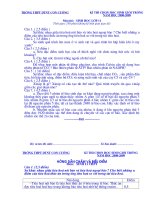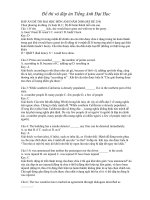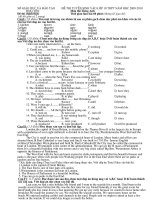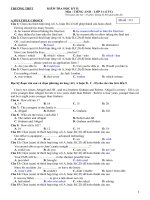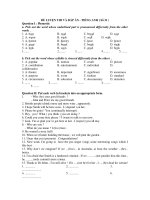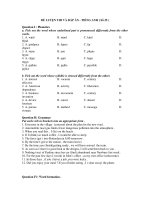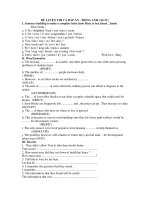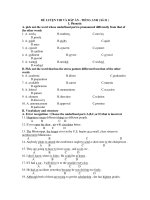- Trang chủ >>
- Đề thi >>
- Đề thi lớp 12
đề thi và đáp án tiếng Việt olympic hóa học quốc tế icho 2012
Bạn đang xem bản rút gọn của tài liệu. Xem và tải ngay bản đầy đủ của tài liệu tại đây (4.21 MB, 100 trang )
Theoretical
Problems
44th International
Chemistry Olympiad
July 26, 2012
United States
of America
Name:
Code:
Instructions
Write your name and code on each page.
This examination has 8 problems and Periodic Table on 49 pages.
You have 5 hours to work on the exam problems. Begin only when the START
command is given.
Use only the pen and the calculator provided.
All results must be written in the appropriate boxes. Anything written elsewhere
will not be graded. Use the back side of the exam sheets if you need scratch paper.
Write relevant calculations in the appropriate boxes when necessary. Full marks
will be given for correct answers only when your work is shown.
When you have finished the examination, put your papers into the envelope
provided. Do not seal the envelope.
You must stop working when the STOP command is given.
Do not leave your seat until permitted by the supervisors.
The official English version of this examination is available on request only for
clarification.
1
th
The 44 IChO – Theoretical Examination. The official English version
Name:
Code:
Physical Constants, Formulas and
Equations
Avogadro's constant, NA = 6.0221 1023 mol–1
Boltzmann constant, kB = 1.3807 10–23 J∙K–1
Universal gas constant, R = 8.3145 J∙K–1∙mol–1 = 0.08205 atm∙L∙K–1∙mol–1
Speed of light, c = 2.9979 108 m∙s–1
Planck's constant, h = 6.6261 10–34 J∙s
Mass of electron, me = 9.10938215 10–31 kg
Standard pressure, P = 1 bar = 105 Pa
Atmospheric pressure, Patm = 1.01325 105 Pa = 760 mmHg = 760 Torr
Zero of the Celsius scale, 273.15 K
1 nanometer (nm) = 10–9 m
1 picometer (pm) = 10–12 m
Equation of a circle, x2 + y2 = r2
r2
r
r3/3
r2
Bragg's Law of Diffraction: sin = n/2d
2
th
The 44 IChO – Theoretical Examination. The official English version
Name:
Code:
1
1
1.00794
18
2
4.00260
H
1
0.28
3
He
13
2
4
6.941 9.01218
Li
2
Atomic number
1
1.00794
Be
H
0.28
5
Atomic weight
Na
6
10.811
Atomic symbol
Covalent radius, Å
11
12
22.9898 24.3050
3
14
15
1.40
17
16
7
8
9
10
12.011 14.0067 15.9994 18.9984 20.1797
B
C
N
O
F
Ne
0.89
0.77
0.70
0.66
0.64
1.50
13
14
15
16
17
18
26.9815 28.0855 30.9738 32.066 35.4527 39.948
Mg
Al
Si
P
S
Cl
Ar
1.17
1.10
1.04
0.99
1.80
3
4
5
6
7
8
9
10
11
12
19
20
21
22
23
24
25
26
27
28
29
30
31
32
33
34
35
36
39.0983 40.078 44.9559 47.867 50.9415 51.9961 54.9381 55.845 58.9332 58.6934 63.546
65.39 69.723
72.61 74.9216
78.96 79.904
83.80
K
4
Ca
Sc
Ti
V
Cr
Mn
Fe
Co
Ni
Cu
Zn
Ga
Ge
As
Se
Br
Kr
1.46
1.33
1.25
1.37
1.24
1.25
1.24
1.28
1.33
1.35
1.22
1.20
1.18
1.14
1.90
37
38
39
40
41
42
43
44
45
46
47
48
49
50
51
52
53
54
85.4678
87.62 88.9059 91.224 92.9064
95.94 (97.905) 101.07 102.906 106.42 107.868 112.41 114.818 118.710 121.760 127.60 126.904 131.29
5
Rb
Sr
Y
55
56
57-71
132.905 137.327
6
Cs
Fr
Nb
Mo
Tc
Ru
Rh
Pd
Ag
Cd
In
Sn
Sb
Te
I
Xe
1.43
1.37
1.36
1.34
1.34
1.37
1.44
1.49
1.67
1.40
1.45
1.37
1.33
2.10
72
73
74
75
76
77
78
79
80
81
82
83
84
85
86
178.49 180.948 183.84 186.207 190.23 192.217 195.08 196.967 200.59 204.383
207.2 208.980 (208.98) (209.99) (222.02)
Ba La-Lu
87
88
89-103
(223.02) (226.03)
7
Zr
1.60
Ra Ac-Lr
Hf
Ta
W
Re
Os
Ir
Pt
Au
Hg
Tl
Pb
Bi
Po
1.59
1.43
1.37
1.37
1.35
1.36
1.38
1.44
1.50
1.70
1.76
1.55
1.67
At
Rn
2.20
104
105
106
107
108
109
110
111
112
113
114
115
116
117
118
(261.11) (262.11) (263.12) (262.12)
(265)
(266)
(271)
(272)
(285)
(284)
(289)
(288)
(292)
(294)
(294)
Rf
Db
Sg
Bh
Hs
Mt
Ds
Rg
Cn
Uut
Fl
Uup
Lv
Uus
UUo
2.25
57
58
59
60
61
62
63
64
65
66
67
68
69
70
71
138.906 140.115 140.908 144.24 (144.91) 150.36 151.965 157.25 158.925 162.50 164.930 167.26 168.934 173.04 174.04
La
Ce
Pr
Nd
Pm
Sm
Eu
Gd
Tb
Dy
Ho
Er
Tm
Yb
Lu
1.87
1.83
1.82
1.81
1.83
1.80
2.04
1.79
1.76
1.75
1.74
1.73
1.72
1.94
1.72
89
90
91
92
93
94
95
96
97
98
99
100
101
102
103
(227.03) 232.038 231.036 238.029 (237.05) (244.06 (243.06) (247.07) (247.07) (251.08) (252.08) (257.10) (258.10)
(259.1) (260.1)
Ac
Th
Pa
U
Np
1.88
1.80
1.56
1.38
1.55
)
Pu
Am
Cm
Bk
Cf
Es
1.73
1.74
1.72
1.99
2.03
Fm
Md
No
Lr
1.59
3
th
The 44 IChO – Theoretical Examination. The official English version
Name:
Code:
PROBLEM 1
a–i
4
7.5% of the total
a–ii
2
a-iii
2
b
2
C
10
Problem 1
20
7.5%
a. Boron Hydrides and Other Boron Compounds
Boron hydride chemistry was first developed by Alfred Stock (1876-1946). More than
20 neutral molecular boron hydrides with the general formula B xHy have been
characterized. The simplest boron hydride is B2H6, diborane.
i. Using the data below derive the molecular formulae for two other members of this
series of boron hydrides, A and B (A and B).
Substance
A
B
State (25 ˚C, 1 bar)
Mass Percent Boron
Liquid
Solid
83.1
88.5
A = _____ B5H11_______
Molar mass
(g/mol)
65.1
122.2
B = ______ B10H14______
2 points each = 4 points
4
th
The 44 IChO – Theoretical Examination. The official English version
Name:
Code:
ii. William Lipscomb received the Nobel Prize in Chemistry in 1976 for “studies on the
structures of boron hydrides illuminating the problems of chemical bonding.” Lipscomb
recognized that, in all boron hydrides, each B atom has a normal 2-electron bond to at
least one H atom (B–H). However, additional bonds of several types occur, and he
developed a scheme for describing the structure of a borane by giving it a styx number
where:
s = number of B–H–B bridges in the molecule
t = the number of 3-center BBB bonds in the molecule
y = the number of two-center B–B bonds in the molecule
x = the number of BH2 groups in the molecule
The styx number for B2H6 is 2002. Propose a structure for tetraborane, B4H10, with a styx
number of 4012.
H
H
H
H
B
H
B
H
H
B
H
B
B
H
H
H
actual structure
H
H
H
B
H
H
B
H
H
B
H
H
unknown but acceptable structure
2 points for either of these structures
5
th
The 44 IChO – Theoretical Examination. The official English version
Name:
Code:
iii. A boron-based compound is composed of boron, carbon, chlorine, and oxygen
(B4CCl6O). Spectral measurements indicate the molecule has two types of B atoms, with
tetrahedral and trigonal planar geometry, in a 1:3 ratio, respectively. These spectra are
also consistent with a CO triple bond. Given that the molecular formula of the
compound is B4CCl6O, suggest a structure for the molecule.
Structure:
O
C
Cl2B
Cl2B
B
BCl2
2 points. Not required to show the stereochemistry
6
th
The 44 IChO – Theoretical Examination. The official English version
Name:
Code:
b. Thermochemistry of Boron Compounds
Estimate the B-B single bond dissociation enthalpy in B2Cl4(g) using the following
information:
Bond
Bond Dissociation Enthalpy (kJ/mol)
B–Cl
443
Cl–Cl
242
Compound
BCl3(g)
B2Cl4(g)
fH° (kJ/mol)
–403
–489
A Born-Haber cycle gives a B-B bond dissociation enthalpy of 327 kJ/mol
2B + 6Cl
rHo = -4 x 443 - 242 kJ - BB
rHo = 6 x 443 kJ
B2Cl4 + Cl2
2BCl3
rHo = +317 kJ
2 points
7
th
The 44 IChO – Theoretical Examination. The official English version
Name:
Code:
c.
Chemistry of Diborane
Give the structure for each numbered compound in the scheme below. Each numbered
compound is a boron-containing compound.
NOTES:
a.
The boiling point of compound 5 is 55 ˚C.
b.
Excess reagents used in all reactions.
c.
The freezing point depression for 0.312 g of compound 2 in 25.0 g of benzene is
0.205 ˚C. The freezing point depression constant for benzene is 5.12 ˚C/molal
8
th
The 44 IChO – Theoretical Examination. The official English version
Name:
Code:
Number
1
Molecular Structure of Compound
OCH3
B
H3CO
B(OCH3)3
2
C6H5
B
O
O
B
OCH3
C6H5
B
O
C6H5
A dimer or tetramer [C6H5BO]x are also acceptable
(x = 2, 4).
3
Cl
B
BCl3 Cl
4
H
BNH6
H
H
B
N
H
H
Cl
H
Formal charges not necessary
5
H
H
H
B 3 N 3 H6
B
N
N
B
B
N
H
H
H
Formal charges not necessary
10 points, 2 points each but only 1 point for formula only
9
th
The 44 IChO – Theoretical Examination. The official English version
Name:
Code:
PROBLEM 2
7.8% of the total
a–i
4
a–ii
4
b-i
6
b-ii
1
c
5
Problem 2
20
7.8%
Platinum(II) Compounds, Isomers, and the Trans Effect.
Platinum and other Group 10 metals form square planar complexes and the mechanisms
of their reactions have been studied extensively. For example, it is known that
substitution reactions of these complexes proceed with retention of stereochemistry.
It is also known that the rate of substitution of ligand X by Y depends on the nature of
the ligand trans to X, that is, on ligand T. This is known as the trans effect. When T is
one of the molecules or ions in the following list, the rate of substitution at the trans
position decreases from left to right.
CN– > H– > NO2–, I– > Br–, Cl– > pyridine, NH3, OH–, H2O
The preparations of cis- and trans-Pt(NH3)2Cl2 depend on the trans affect. The
preparation of the cis isomer, a cancer chemotherapy agent commonly called cisplatin,
involves the reaction of K 2PtCl4 with ammonia.
10
th
The 44 IChO – Theoretical Examination. The official English version
Name:
Code:
i. Draw all possible stereoisomers for square planar platinum(II) compounds with the
formula Pt(py)(NH3)BrCl (where py = pyridine, C 5H5N).
py
Pt
Pt
Pt
py
NH3
Br
py
Cl
Br
Br
Cl
NH3
NH3
Cl
4 points. Penalty of -1 for excessive number of structures
3D perspective structures not required. Need clear indication of relative location of
ligands.
ii. Write reaction schemes including intermediate(s), if any, to show the preparation in
aqueous solution for each of the stereoisomers of [Pt(NH 3)(NO2)Cl2]— using, as
reagents, PtCl42-, NH3, and NO2-. The reactions are controlled kinetically by the trans
effect.
cis-isomer:
2–
Cl
Cl
NO2
Cl
Pt
Pt
Cl
NO2–
Cl
Cl
NH3
Cl
Pt
Cl
NH3
Cl
Cl
Cl
NH3
2 points
trans-isomer:
2-
2–
Cl
Cl
NO2
–
Cl
Cl
Cl
H3N
Pt
Pt
Cl
NH3
Pt
NO2
Cl
NO2
2 points
11
th
The 44 IChO – Theoretical Examination. The official English version
Name:
Code:
b.
Kinetic Studies of Substitution Reactions of Square Planar Complexes
Substitutions of the ligand X by Y in square planar complexes
ML3X + Y ML3Y + X
can occur in either or both of two ways:
• Direct substitution: The incoming ligand Y attaches to the central metal, forming a
five-coordinate complex, which then rapidly eliminates a ligand, X, to give the product,
ML3Y.
–X
+Y
ML3X
[ML3XY]
**
** = rate determining step, Rate constant = kY
ML3Y
• Solvent-assisted substitution: A solvent molecule S attaches to the central metal to
give ML3XS, which eliminates the X to give ML3S. Y rapidly displaces S to give ML3Y.
–X
+S
ML3X
[ML3XS]
**
+Y
[ML3S]
–S
ML3Y
** = rate determining step, Rate constant = kS
The overall rate law for such substitutions is
Rate = ks[ML3X] + kY[Y][ML3X]
When [Y] >> [ML3X], then Rate = kobs[ML3X].
The values of ks and kY depend on the reactants and solvent involved. One example is
the displacement of the Cl– ligand in a square planar platinum(II) complex, ML2X2, by
pyridine (C5H5N). (The ML3X scheme above applies to ML2X2.)
Cl
N
Pt
N
CH3OH
+ Cl-
Pt
+
Cl
N
N
N
N
Cl
Data for reaction at 25 ˚C in methanol where [pyridine] >> the concentration of the
platinum complex are given in the table below.
12
th
The 44 IChO – Theoretical Examination. The official English version
Name:
Code:
Concentration of pyridine (mol/L)
0.122
0.061
0.030
kobs (s–1)
7.20 x 10–4
3.45 x 10–4
1.75 x 10–4
i. Calculate the values of ks and kY. Give the proper unit for each constant.
A grid is given if you wish to use it.
kY = 5.8 x 10–3 s–1M–1
kS = 0 s–1 (allow small range of values, ± 0.2 10–3)
6 points
1 point for each unit
1 point for each number
2 points for method
13
th
The 44 IChO – Theoretical Examination. The official English version
Name:
Code:
kY = 5.8 x 10–3 s–1M–1
kS = 0 s–1 (allow small range of values, + or – 0.2 x 10–3)
6 points
1 point for each unit
1 point for each number
2 points for method
14
th
The 44 IChO – Theoretical Examination. The official English version
Name:
Code:
ii. When [pyridine] = 0.10 mol/L, which of the following is true? (Tick the box next to
the correct answer.)
Most pyridine product is formed by the solvent-assisted (ks) substitution pathway.
X
Most pyridine product is formed by the direct substitution (kY) pathway
Comparable amounts of product are formed by the two pathways.
No conclusions may be drawn regarding the relative amounts of product produced
by the two pathways.
1 point for (b)
c. A chemotherapy agent
In an effort to better target cisplatin to cancer cells, Professor Lippard’s group at MIT
attached a platinum(IV) complex to oligonucleotides bound to gold nanoparticles.
Gold nanoparticle Oligonucleotide
Pt(IV) complex attached
Experiments showed that a gold nanoparticle with a diameter of 13 nm. Attached to this
nanoparticle are 90 oligonucleotide groups, with 98% of them being bound to a Pt(IV)
complex. Suppose that the reaction vessel used for treating cells with the Pt(IV)
nanoparticle reagent had a volume of 1.0 mL and that the solution was 1.0 x 10 –6 M in
Pt. Calculate the mass of gold and of platinum used in this experiment. (The density
of gold = 19.3 g/cm3 and the volume of a sphere = (4/3)πr 3 = 4.18879 r3.)
15
th
The 44 IChO – Theoretical Examination. The official English version
Name:
Code:
Mass of platinum
a) Amount of Pt used = (1.0 x 10–6 mol/1000 mL)(1.0 mL) = 1.0 x 10–9 mol Pt
This is equivalent to 2.0 x 10–7 g Pt
1 point
Mass of gold
b) (90 groups/nanoparticle)(0.98 Pt bound complexes)
= 88 Pt complexes/nanoparticle or 88 Pt atoms per nanoparticle
c) 1.0 x 10–9 mol Pt is equivalent to 6.0 x 1014 Pt atoms
d) (6.0 x 1014 Pt atoms)(1 nanoparticle/88 Pt atoms) = 6.8 x 1012 nanoparticles
e) Size of gold nanoparticles:
Radius = 6.5 x 10–7 cm and volume of gold nanoparticle = 1.2 x 10–18 cm3
Mass of gold nanoparticle = 2.3 x 10–17 g
Amount of gold in a nanoparticle = 1.2 x 10–19 mol
Atoms of gold in a nanoparticle = 7.1 x 104 atoms
f) Mass of gold:
Total number of gold atoms = (6.8 x 1012 particles)(7.1 x 104 atoms/particle)
= 4.8 x 1017 atoms of gold
Equivalent to 1.5 x 10–4 g gold
4 points
16
th
The 44 IChO – Theoretical Examination. The official English version
Name:
Code:
PROBLEM 3
7.5 % of the Total
a
4
b
12
c-i
6
c-ii
12
Problem 3
34
7.5%
Thiomolybdate ions are derived from molybdate ions, MoO42–, by replacing oxygen atoms
with sulfur atoms. In nature, thiomolybdate ions are found in such places as the deep
waters of the Black Sea, where biological sulfate reduction generates H2S. The molybdate
to thiomolybdate transformation leads to rapid loss of dissolved Mo from seawater to
underlying sediments, depleting the ocean in Mo, a trace element essential for life.
The following equilibria control the relative concentrations of molybdate and
thiomolybdate ions in dilute aqueous solution.
MoS42– + H2O(l)
MoOS32– + H2O(l)
MoO2S22– + H2O(l)
MoO3S2– + H2O(l)
MoOS32– + H2S(aq)
MoO2S22– + H2S(aq)
MoO3S2– + H2S(aq)
MoO42– + H2S(aq)
K1 = 1.3×10–5
K2 = 1.0×10–5
K3 = 1.6×10–5
K4 = 6.5×10–6
a. If at equilibrium a solution contains 1×10–7 M MoO42– and 1×10–6 M H2S(aq), what
would be the concentration of MoS42–?
Multiplying the mass action laws for the four given reactions produces:
[MoS42–] =
7×10–12
Units: M
3 points for correct MoS42– answer; 1 point correct units
17
th
The 44 IChO – Theoretical Examination. The official English version
Name:
Code:
Solutions containing MoO2S22–, MoOS32– and MoS42– display absorption peaks in the
visible wavelength range at 395 and 468 nm. The other ions, as well as H2S, absorb
negligibly in the visible wavelength range. The molar absorptivities (ε) at these two
wavelengths are given in the following table:
ε at 468 nm
L mol–1 cm–1
MoS42–
ε at 395 nm
L mo–-1 cm–1
11870
120
MoOS32–
0
9030
MoO2S22–
0
3230
b. A solution not at equilibrium contains a mixture of MoS42–, MoOS32– and MoO2S22–
and no other Mo-containing species. The total concentration of all species containing Mo
is 6.0×10–6 M. In a 10.0 cm absorption cell, the absorbance of the solution at 468 nm is
0.365 and at 395 nm is 0.213. Calculate the concentrations of all three Mo-containing
anions in this mixture.
MoS42– concentration is determined by absorbance at 468 nm:
0.365 = (11870)(10.0)(MoS42–).
(MoS42–) = 3.08×10–6 M
4 points
From conservation of Mo,
(MoOS32–) + (MoO2S22–) = MoTotal – (MoS42–) = 6.0×10–6 – 3.08×10–6 = 2.9×10–6
By rearrangement,
–
–
–
(MoO2S22 ) = 2.9×10 6 ‒ (MoOS32 )
From optical absorbance at 395 nm,
0.213 =(120)(10.0)(3.08×10–6)+ (9030)(10.0)(MoOS32–) + (3230)(10.0)(MoO2S22–)
0.213 = (120)(10.0)(3.08×10–6)+ (9030)(10.0)(MoOS32–) + (3230)(10.0)(2.9×10–6 ‒
(MoOS32–))
(MoOS32–) = 2.0×10–6 M
4 points
(MoO2S22–) = 2.9×10–6 – (MoOS32–) = 0.9×10–6 M
(MoO2S22–) = 0.9×10–6 M
4 points
–
MoO2S22 _____
MoOS32– ______
MoS42– _______
18
th
The 44 IChO – Theoretical Examination. The official English version
Name:
Code:
c. A solution initially containing 2.0×10–7 M MoS42– hydrolyzes in a closed system. The
H2S product accumulates until equilibrium is reached. Calculate the final equilibrium
concentrations of H2S(aq), and all five Mo-containing anions (that is, MoO42–, MoO3S2–,
MoO2S22–, MoOS32– and MoS42–). Ignore the possibility that H2S might ionize to HS–
under certain pH conditions. (One-third credit is given is given for writing the six
independent equations that constrain the problem, and two-thirds credit is given for the
correct concentrations.)
i. Write the six independent equations that determine the system.
Mass balance for Mo:
2.0×10–7 = (MoS42–) + (MoOS32–) + (MoO2S22–) + (MoO3S2–) + (MoO42–)
2 points
Mass balance for S:
–
–
–
–
–
8.0×10 7 = 4(MoS42 ) + 3(MoOS32 ) + 2(MoO2S22 ) + (MoO3S2 ) + (H2S)
2 points
Equilibrium constants:
1.3×10–5 = (MoOS32–)(H2S)/(MoS42–)
1.0×10–5 = (MoO2S22–)(H2S)/(MoOS32–)
1.6×10–5 = (MoO3S2–)(H2S)/(MoO2S22–)
6.5×10–6 = (MoO42–)(H2S)/(MoO3S2–)
0.5 point each = 2 points
Six equations in any format will be accepted provided they somehow introduce the four
equilibrium constants and the two correct mass balance constraints.
19
th
The 44 IChO – Theoretical Examination. The official English version
Name:
Code:
ii. Calculate the six concentrations making reasonable approximations, giving your
answers to two significant figures.
It is likely that multiple approaches will be found for solving these equations. Here is one
approach:
The maximum possible H2S concentration is 8.0x10–7 M, the amount formed if complete
hydrolysis occurs. At this H2S concentration, MoO3S2– is only about 12% of (MoO42–)
and the remaining thio anions are much less abundant. Therefore, because the problem
justifies a solution that is precise only to two significant figures, the mass balance
equations can be truncated:
2.0×10–7 = (MoO3S2–) + (MoO42–)
8.0×10–7 = (MoO3S2–) + (H2S)
(Mo mass balance)
(S mass balance)
Subtracting the first from the second and rearranging gives:
(MoO42–) = (H2S) - 6.0×10–7
Likewise, the S mass balance can be rearranged,
(MoO3S2–) = 8.0×10–7 – (H2S)
Employing the equilibrium constant for the reaction involving MoO42– and MoO3S2–
[
]
[
]
Rearrangement and solution by the quadratic formula gives (H2S). Back substitution gives
the remaining concentrations.
H2S __7.8×10–7 M __ MoO42– ___1.8×10–7 M
MoO2S22– ___1.0×10–9 M
___
MoO3S2–___2.1×10–8 M___
MoOS32– ___8.1×10–11 M___ MoS42– ___4.9×10–12 M___
2 points each answer; 12 points total
20
th
The 44 IChO – Theoretical Examination. The official English version
Name:
Code:
PROBLEM 4
a b
12 14
c
10
d-i
4
7.8% of the Total
d-ii
2
d-iii
2
d-iv
4
e-i
4
e-ii
8
Problem 4
60
7.8%
In the 1980’s a class of ceramic materials was discovered that exhibits superconductivity
at the unusually high temperature of 90 K. One such material contains yttrium, barium,
copper and oxygen and is called “YBCO”. It has a nominal composition of YBa2Cu3O7,
but its actual composition is variable according to the formula YBa2Cu3O7- (0 < < 0.5).
a. One unit cell of the idealized crystal structure of YBCO is shown below. Identify
which circles correspond to which elements in the structure.
= Cu
= O
= Ba
= Y
c
3 points each; 12 points total
b
a
21
th
The 44 IChO – Theoretical Examination. The official English version
Name:
Code:
The true structure is actually orthorhombic (a ≠ b ≠ c), but it is approximately tetragonal,
with a b (c/3).
b. A sample of YBCO with = 0.25 was subjected to X-ray diffraction using Cu K
radiation ( = 154.2 pm). The lowest-angle diffraction peak was observed at 2 = 7.450º.
Assuming that a = b = (c/3), calculate the values of a and c.
sin = n/2d
d = (1)(154.2 pm)/2sin(3.725º)
d = 1187 pm
Lowest-angle => d = longest axis = c
c = 1187 pm
a = c/3 = 396 pm
8 points for calculating d; 6/8 points if student uses in radians and reports a positive
value (0/8 points if negative distance); 6/8 points if uses 2 instead of .
6 points for correctly assigning a and c.
14 points total
a = 396 pm
c = 1187 pm
c. Estimate the density of this sample of YBCO (with = 0.25) in g cm-3. If you do not
have the values for a and c from part (b), then use a = 500. pm, c = 1500. pm.
Vunit cell = a b c = 3a3 = 3(396 pm)3 = 1.863 10-22 cm3
munit cell = (1/NA)(88.91 + 2×137.33 + 3×63.55 + 6.75×16.00)
munit cell = (662.22 g/mol)/(6.0221 1023 mol-1) = 1.100 10-21 g
Density = (1.100 10-21 g)/(1.863 10-22 cm3) = 5.90 g cm-3
4 points for V
4 points for munit cell
2 points for
Density = 5.90 g cm-3
10 points total
d. When YBCO is dissolved in 1.0 M aqueous HCl, bubbles of gas are observed
(identified as O2 by gas chromatography). After boiling for 10 min to expel the dissolved
22
th
The 44 IChO – Theoretical Examination. The official English version
Name:
Code:
gases, the solution reacts with excess KI solution, turning yellow-brown. This solution
can be titrated with thiosulfate solution to a starch endpoint. If YBCO is added directly to
a solution that 1.0 M in both KI and HCl under Ar, the solution turns yellow-brown but no
gas evolution is observed.
i.
Write a balanced net ionic equation for the reaction when solid YBa2Cu3O7-
dissolves in aqueous HCl with evolution of O2.
YBa2Cu3O7- (s) + 13 H+ (aq)
Y (aq) + 2 Ba (aq) + 3 Cu2+ (aq) + (0.25[1 – 2])O2 (g) + 6.5 H2O (l)
3+
2+
2 points species, 2 points coefficients
ii.
Write a balanced net ionic equation for the reaction when the solution from (i) reacts
with excess KI in acidic solution after the dissolved oxygen is expelled.
2 Cu2+ (aq) + 5 I– (aq) 2 CuI (s) + I3– (aq)
–or–
2+
–
2 Cu (aq) + 4 I (aq) 2 CuI (s) + I2 (aq)
1 point species, 1 point coefficients. Iodo complexes of Cu(I) (e.g., CuI2– ) will be given
full marks as products
iii.
Write a balanced net ionic equation for the reaction when the solution from (ii) is
titrated with thiosulfate (S2O32-).
I3– (aq) + 2 S2O32– (aq) 3 I– (aq) + S4O62– (aq)
–or–
I2 (aq) + 2 S2O32– (aq) 2 I– (aq) + S4O62– (aq)
1 point species, 1 point coefficients
23
th
The 44 IChO – Theoretical Examination. The official English version
Name:
iv.
Code:
Write a balanced net ionic equation for the reaction when solid YBa2Cu3O7-
dissolves in aqueous HCl containing excess KI in an Ar atmosphere.
YBa2Cu3O7- (s) + (14 – 2) H+ (aq) + (9 – 3) I– (aq)
Y3+ (aq) + 2 Ba2+ (aq) + 3 CuI (s) + (7 – ) H2O (l) + (2 – ) I3– (aq)
–or–
YBa2Cu3O7- (s) + (14 – 2) H+ (aq) + (7 – 2) I– (aq)
Y3+ (aq) + 2 Ba2+ (aq) + 3 CuI (s) + (7 – ) H2O (l) + (2 – ) I2 (aq)
2 points species, 2 points coefficients
e. Two identical samples of YBCO with an unknown value of were prepared. The first
sample was dissolved in 5 mL of 1.0 M aqueous HCl, evolving O2. After boiling to expel
gases, cooling, and addition of 10 mL of 0.7 M KI solution under Ar, titration with
thiosulfate to the starch endpoint required 1.542 10-4 mol thiosulfate. The second sample
of YBCO was added directly to 7 mL of a solution that was 1.0 M in KI and 0.7 M in HCl
under Ar; titration of this solution required 1.696 10-4 mol thiosulfate to reach the
endpoint.
i. Calculate the number of moles of Cu in each of these samples of YBCO.
nCu = nthiosulfate in the first titration
nCu = 1.542 10–4 mol
4 points, errors in chemistry displayed in (d) will be carried forward without penalty
nCu = 1.542 10–4 mol
ii. Calculate the value of for these samples of YBCO.
Total Cu = 1.542 10–4 mol
Cu(III) = (1.696 10–4 mol) – (1.542 10–4 mol) = 1.54 10–5 mol
So 90% of Cu is Cu(II), 10% is Cu(III)
For charge balance, 2(7 – ) = 3 + 2×2 + 3×(0.90×2 + 0.10×3) = 13.30
= 0.35
4 points for partition of Cu(III)/Cu(II)
4 points for calculating
Alternatively, using the balanced equations in (d):
In the 1st titration, each mol YBCO = 1.5 mol I3– = 3 mol S2O32–
In the 2d titration, each mol YBCO = (2–) mol I3– = (4–2) mol S2O32–
24
th
The 44 IChO – Theoretical Examination. The official English version

